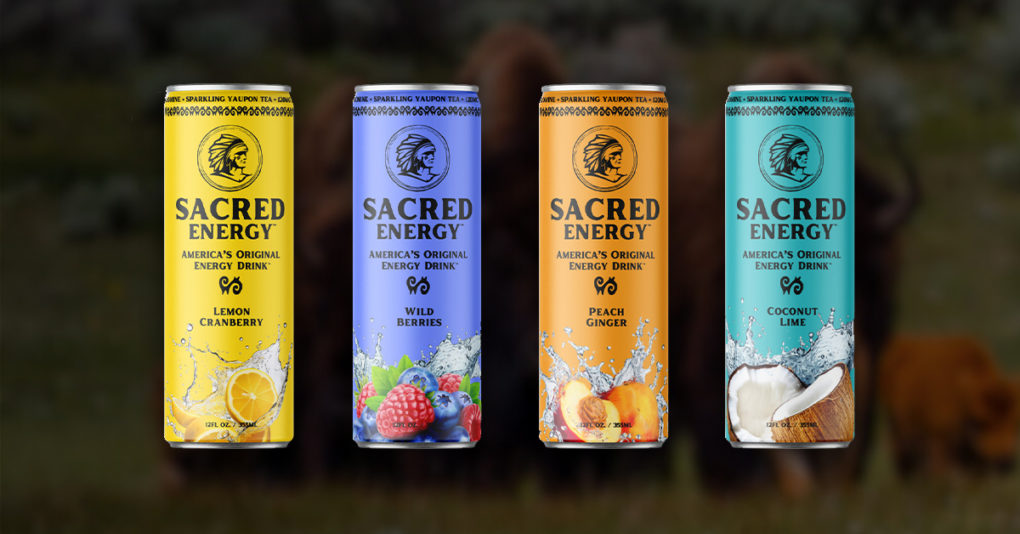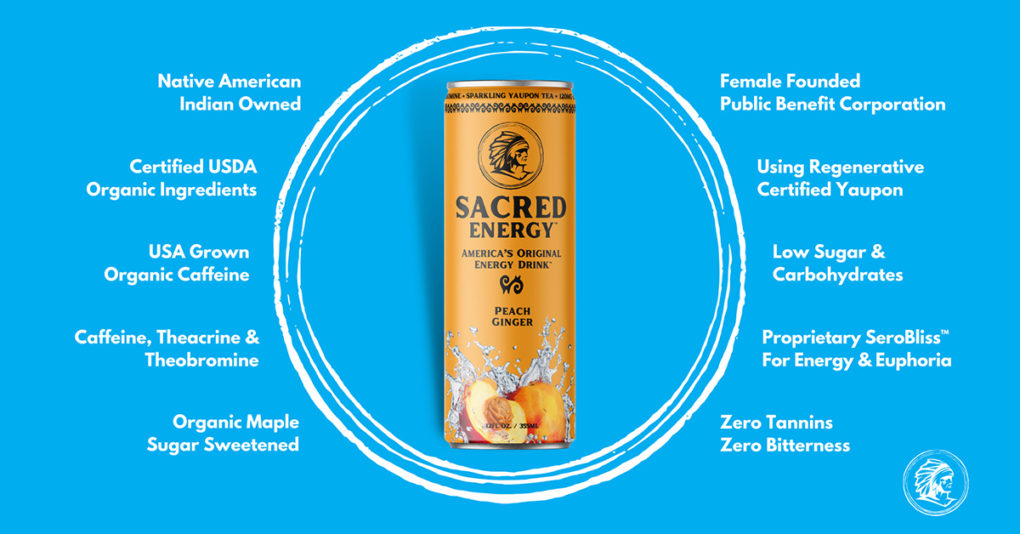As the functional and better-for-you energy drink category booms, a new startup brand is looking to use yaupon – a naturally caffeinated North American plant – and other functional ingredients to meet consumer demand for healthier energy.
Sacred Energy was founded this year by Paul Frantellizzi, a CPG entrepreneur specializing in natural health and wellness foods and supplements, along with his wife and chief brand officer Pamela Peters and business partner Billy Brown, the owner of yerba mate products maker Sol Mate Beverage Group.
The brand is not in the market yet – it is currently testing formulations with co-packers and flavor houses – but Frantellizzi, who is serving as co-CEO with Brown, told BevNET he is hoping to have products ready to roll out in Texas by the middle of the year. The drinks will debut with four flavors: Lemon Cranberry, Wild Berries, Peach Ginger and Coconut Lime. Each 12 oz. can will contain 120 mg of caffeine and less than 5 grams of sugar at an SRP of $3.49 each.
Since 2007, Frantellizzi and Peters have founded a number of natural products startups, including organic chocolate maker Good Superfoods, natural snacks brand Earthpure Organics, and his most recent venture, a functional mushroom products brand called Blue Toad Botanicals. Frantellizzi also spent several years working in the hemp CBD space, serving as chief innovation officer and EVP of operations, respectively, at Stanley Brothers USA, the company behind pioneering CBD brand Charlotte’s Web, from 2018 to 2019, and later as CEO and chief innovation officer of hemp-derived product maker Blissful Plant from January 2020 through the end of 2021.
In addition to yaupon, Sacred Energy’s drinks also use a proprietary blend of functional ingredients it calls SeroBliss, which includes griffonia, damiana, kava kava, kanna, mucuna and sacred lotus, intended to “engage consumers’ serotonin and dopamine receptors,” according to an investor deck, with the intent of providing a level, mood-enhancing buzz without a crash.
All of the ingredients in the SeroBliss blend are plant-based, and in particular kava has become an increasingly popular ingredient in some RTDs. However, kava has also been subject to FDA warning letters in the past for potential side effects.
Beyond energy drinks, Frantellizzi said the company is also exploring additional product formats, including powder mixes and gummies, with an eye on a 2025 launch.
“We’re really looking to expand the demographic [of energy drinks]” he said. “We want to include the 18-to-34 demographic, but we also think there’s a great opportunity with multiple demographics from boomers, where I sit, all the way down to stay-at-home moms who are looking for a midday energy boost that’s not going to give them a giant boost and a crash, but something that’s nice and smooth, but also an euphoric feeling.”
Making A Native-Owned Brand
Frantellizzi first became interested in natural health and alternative medicine in the 2000s after suffering a debilitating case of lyme disease, which he said had him feeling as though he were “near death” for roughly five years. He credited a blend of traditional Chinese medicine and ayurvedic remedies with improving his health after modern Western medicine had failed to treat the lingering symptoms of the disease.
He had been researching yaupon, which is indigenous to the Southern U.S. – particularly Texas and Florida – when his family received the results of DNA tests that showed his wife, Pamela Peters, had Taíno heritage – a tribe primarily from the Caribbean – while their son discovered he was Houma, a group indigenous to Louisiana.
Yaupon has been historically used by multiple Native American tribes as a ceremonial beverage, and the timing of the family’s discovery about their own ancestry inspired the branding, including the “Sacred” name and the Native American chieftain logo.
Frantellizzi personally has no Native American heritage himself, but he said he’s been cautious around concerns that he could appear to be appropriating Native culture for the brand, which has multiple co-owners and partners who are from various tribes. In addition to being a co-founder, Peters is also the company’s chief brand officer. The company also brought in Abianne Falla, the owner of its main ingredient supplier CatSpring Yaupon and a member of the Chickasaw Nation, as a co-owner in the business.
Sacred Energy has also joined the Native American Business Association (NABA), where Frantellizzi said members of the group have been supportive of the brand.
“Culturally, we have this perception and we have to be really careful in how we present Native American culture,” he said. “Everyone I’ve spoken to has been just 100% supportive.”
As the brand prepares to launch, Frantellizzi said the company is aiming to build the identity around not just historical traditions, but modern day Native American culture as well; for example, the company is currently looking to recruit competitive lacrosse players to serve as brand ambassadors.
“Everything we’re doing has to come from a place of wanting to put out a great product that is healthy, safe, and tells a wonderful story about our culture,” he said. “And I think if we do all that properly, and it really comes from the heart, it will be hopefully noticed by consumers and appreciated by consumers.”
Once it launches, Sacred Energy will look to employ an omnichannel strategy, Frantellizzi said, but intends to focus on a regional launch around Texas before looking to expand around the country. Most likely, he said, the company will plan to work with DSD distributors and seek out natural and conventional grocery stores alongside ecommerce sales through D2C and Amazon.
The company is currently raising seed capital and has made an investors deck available on its website. As well, Frantellizzi said the brand will be at Expo West in Anaheim next month seeking out potential investors.
The Case for Yaupon
Ready-to-drink yaupon tea brands have existed in the U.S. market for several years but it has remained a niche format: startup brand Yayaya released bottled beverages around 2019 and in 2022 Rambler Sparkling Water unveiled its own yaupon-powered energy drink. Meanwhile, Texas-based Greenbelt Kombucha has its own line of yaupon-based canned kombuchas and an industry group, the American Yaupon Association, has formed in recent years to help promote the ingredient. Whole Foods Market even named yaupon one of its top 10 food trends for 2023.
Yaupon also shares a lot of similarities with a more familiar tea-adjacent beverage: yerba mate. Both are naturally caffeinated plants in the holly family, but there’s several notable differences between the two, starting with the fact that yaupon lacks tannins, resulting in a much less bitter taste profile that proponents believe will make it more palatable to American consumers.
Although the market for yerba mate is much more established in the U.S., it’s still a strikingly small category, especially when compared to the more than $20.2 billion energy drink set it’s typically adjacent to. Leading RTD yerba brand Guayaki has seen significant growth in recent years, up 9.7% to around $155.9 million in the 52-weeks ending December 31, 2023 in MULO and convenience retail accounts, according to Circana. But others like Yachak (-12.7%) and CLEAN Cause (-15.4%) have lagged in sales performance.
Even as better-for-you performance energy drinks have driven growth in the set, plant-based options have tended to struggle to achieve mainstream dominance in the market: Dwayne “The Rock” Johnson’s plant-based ZOA brand was down -37.1% in retail in the same period, Circana reported. Last month, The Vita Coco Company officialled discontinued its plant-based energy offering Runa.
With yaupon, Frantellizzi said introducing the ingredient to consumers will require a lot of storytelling, but he believes that consumers will respond to the flavor and functional benefits.
“[We have] come up with something very, very different from a feeling perspective, but also from the historical use of yaupon perspective,” he said. “It kind of came out of nowhere and took me by surprise two months ago.”

